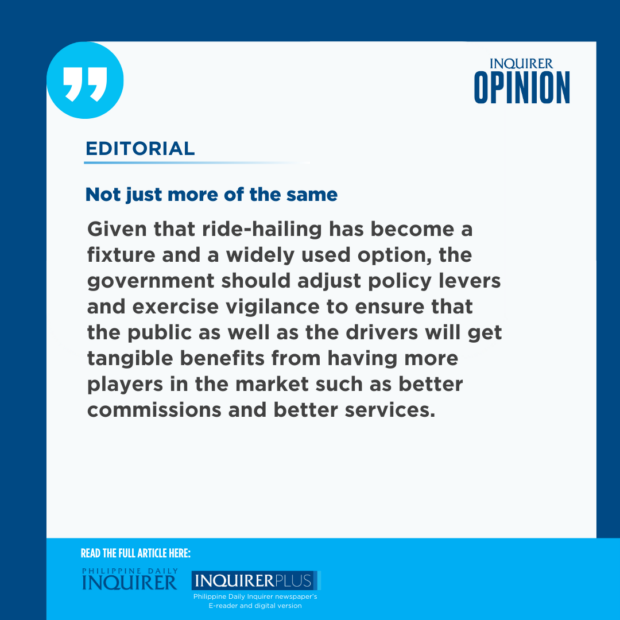Not just more of the same

Commuters who depend on ride-hailing services have reason to cheer after the Land Transportation Franchising and Regulatory Board (LTFRB) widened the pool of accredited transportation network companies (TNC) from five to 19, which should usher in greater competition in the app-based transportation sector.
According to LTFRB chair Teofilo Guadiz III, accrediting more TNCs—including PureRide Corp., Angkas Technologies, Para Xpress Technology Services Inc., and Unified Transport Operations League Corp.—is in line with their mandate “to ensure that the riding public continues to benefit from advancements in transportation services.”
Users had indeed long clamored for more players to join incumbents such as market leader Grab Philippines because of the fervent hope that with more options, services should dramatically improve and surge pricing—or the spike in fares during times of peak demand—will be tempered, thus making fares within easier reach of more Filipinos crying out for quality and reliable mobility services.
This is, however, also contingent on the LTFRB taking steps to ensure that the 65,000 slots for transport network vehicle service (TNVS)—referring to the actual four-wheeled vehicles connected with the ride-hailing apps—be immediately filled up so that users in Metro Manila, Bulacan, Cavite, Laguna, and Rizal can get a ride just minutes after booking a service.
Price surges
As of March this year, however, only 32,000 TNVS slots have been taken despite the clamor for additional transport and delivery services has been growing with economic activity close to regaining its full vigor since being laid low by the devastating impact of the enforced quarantines imposed to contain the spread of the COVID-19 virus.
The imbalance between supply and demand had led to inconveniences such as long waits to book a vehicle and price surges.
The LTFRB did say that it wants “to support the expanding ride-hailing market,” adding that the move “underscores our commitment to fostering a competitive environment that prioritizes commuter welfare and accessibility.”
But at the same time, it was mum on whether it would finally implement its own resolution issued last March to add as many as 10,000 TNVS slots for Metro Manila and adjacent provinces, to exceed the original limit of 65,000 as determined back in 2018 for Greater Metro Manila.
To recall, the LTFRB indefinitely postponed the awarding of additional slots last April due to the strong and valid opposition from transport groups who feared losing more of their market to the app as well as fears of worsening traffic congestion in the region, which would then mean fewer trips and therefore lower revenues.
Transportation landscape
Worsening traffic is a legitimate concern as more accredited firms will necessarily mean more vehicles on the road, which was not the original intention of ride-hailing services when first introduced in 2015.
That year, the Philippines became the first country to regulate the ride-sharing or app-based ride-hailing services then offered by Grab and the defunct Uber, which filled the need for on-demand transportation services.
As envisioned, the cars joining the network should be existing vehicles that will offer the transportation service during downtimes or when they are not being used by their owners/drivers. This means maximizing the use of existing private vehicles on the road.
The system has evolved significantly over the next nine years such that new cars had to be added because of the demand. Indeed, ride hailing has become an indispensable part of the transportation landscape with services expanding from just transportation to deliveries and lately adding even motorcycles to the network.
Safe and comfortable ride
But while increasing competition in this space is a good move, this should not blind policymakers to the fact that this sector grew exponentially because the public transportation system has been so inadequate.
As a result, many Filipinos have come to rely on the ride-hailing system to get a safe and comfortable ride even if they will have to easily pay twice what they would normally pay for a cab, or take a motor taxi to get to their places of work on time because of the traffic.
The government should thus not lose sight of its mandate to streamline the public transportation system to make it affordable, safe, and reliable.
In the meantime, given that ride hailing has become a fixture and a widely used option, the government should adjust policy levers and exercise vigilance to ensure that the public as well as the drivers will get tangible benefits from having more players in the market such as better commissions and better services.
Otherwise, Filipinos will not really get more options with the entry of more players. Rather, just more of the same.




















